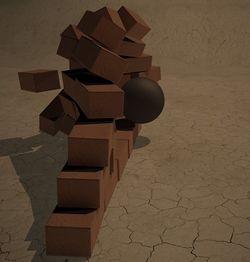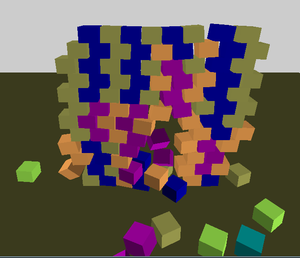Difference between revisions of "Project1W16"
(Created page with "=Homework Assignment 1: Wrecking Ball= For this assignment you can obtain 100 points, plus up to 10 points of extra credit. The goal of this assignment is to create an appli...") |
(→Homework Assignment 1: Wrecking Ball) |
||
| Line 1: | Line 1: | ||
| − | =Homework Assignment 1: | + | =Homework Assignment 1: Tornado= |
For this assignment you can obtain 100 points, plus up to 10 points of extra credit. | For this assignment you can obtain 100 points, plus up to 10 points of extra credit. | ||
| − | The goal of this assignment is to create an application which uses the physics engine to simulate a | + | The goal of this assignment is to create an application which uses the physics engine to simulate a tornado hitting a brick wall. |
This assignment is due on '''Friday, January 15th at 2:00pm'''. | This assignment is due on '''Friday, January 15th at 2:00pm'''. | ||
| Line 25: | Line 25: | ||
==The Project (100 Points)== | ==The Project (100 Points)== | ||
| − | Create an interactive application, in which the user can | + | Create an interactive application, in which the user can control a tornado with the mouse and destroy a brick wall with it. You will get points for the following things: |
* A ground plane nothing can fall through. (10 points) | * A ground plane nothing can fall through. (10 points) | ||
| − | * A wall of bricks, which can be composited of simple [https://www.opengl.org/documentation/specs/glut/spec3/node82.html glutSolidCube]s or | + | * A wall of bricks, which can be composited of simple [https://www.opengl.org/documentation/specs/glut/spec3/node82.html glutSolidCube]s or boxes. Use as many bricks as your computer can render at 30 frames per second (you can manually tweak this number). In Bullet, the cubes can be simulated as [http://bulletphysics.org/Bullet/BulletFull/classbtBoxShape.html btBoxShape]. (15 points) |
| − | * A | + | * A tornado: you can model it as a vertical cylinder, but are free to use a different shape such as a cone. Initially the tornado should be far enough from the wall to not affect it. (15 points) |
| − | * | + | * Add the ability to control the tornado to move it around with the mouse. Allow the user to click on a place on the ground plane and then move the tornado to this point slowly. (15 points) |
| − | + | * When the tornado hits a brick it should either move it tangentially to the tornado's cylinder surface, or make it stick to the tornado. Optionally, you can have the brick move towards the center of the tornado and up to resemble a real tornado more. (30 points) | |
| − | * | + | |
| − | + | ||
* The simulation should run until the space bar is pressed, at which point it should get reset to the initial state with an intact wall. (5 points) | * The simulation should run until the space bar is pressed, at which point it should get reset to the initial state with an intact wall. (5 points) | ||
| Line 42: | Line 40: | ||
==Extra Credit (10 Points)== | ==Extra Credit (10 Points)== | ||
| − | |||
| − | |||
Revision as of 15:49, 6 January 2016
Contents |
Homework Assignment 1: Tornado
For this assignment you can obtain 100 points, plus up to 10 points of extra credit.
The goal of this assignment is to create an application which uses the physics engine to simulate a tornado hitting a brick wall.
This assignment is due on Friday, January 15th at 2:00pm.
The assignment is to be done in teams of two.
We are offering a homework discussion in WLH 2204 on 'Monday, January 11th at 6pm.
You can choose to do this project in C++ with OpenGL and optionally OpenSceneGraph, or Unity 3D.
C++
To add physics effects, you should use the Bullet Physics Library. This library allows assigning physical properties such as weight and softness to geometrical objects. Then the physics engine will calculate the objects' motion, applying the laws of physics.
Here is an excellent tutorial on the Bullet Engine.
Unity 3D
Unity 3D comes with a built-in physics engine, it's called PhysX.
The Project (100 Points)
Create an interactive application, in which the user can control a tornado with the mouse and destroy a brick wall with it. You will get points for the following things:
- A ground plane nothing can fall through. (10 points)
- A wall of bricks, which can be composited of simple glutSolidCubes or boxes. Use as many bricks as your computer can render at 30 frames per second (you can manually tweak this number). In Bullet, the cubes can be simulated as btBoxShape. (15 points)
- A tornado: you can model it as a vertical cylinder, but are free to use a different shape such as a cone. Initially the tornado should be far enough from the wall to not affect it. (15 points)
- Add the ability to control the tornado to move it around with the mouse. Allow the user to click on a place on the ground plane and then move the tornado to this point slowly. (15 points)
- When the tornado hits a brick it should either move it tangentially to the tornado's cylinder surface, or make it stick to the tornado. Optionally, you can have the brick move towards the center of the tornado and up to resemble a real tornado more. (30 points)
- The simulation should run until the space bar is pressed, at which point it should get reset to the initial state with an intact wall. (5 points)
Let these images inspire you for what your application could look like:

